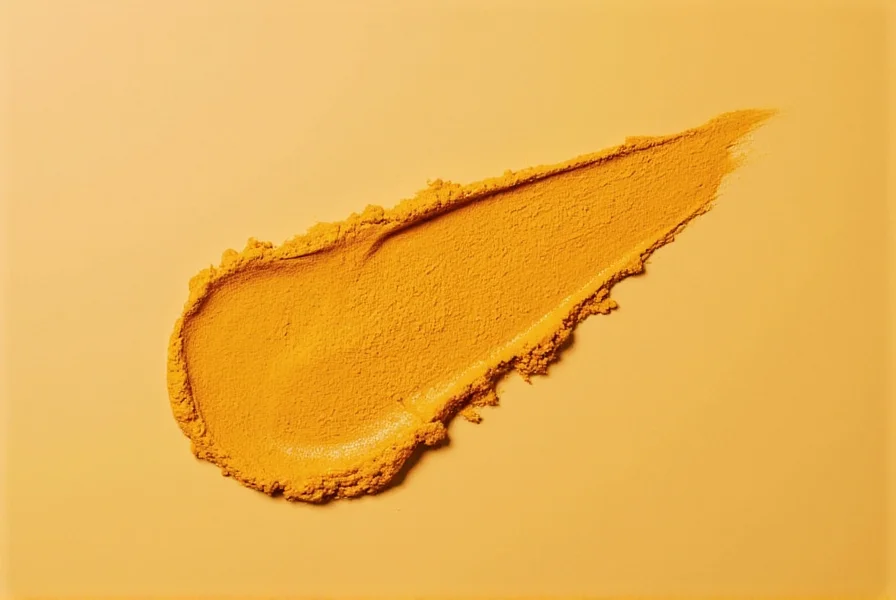For centuries, traditional medicine systems across Asia have harnessed turmeric's golden power for skin care. Modern science now validates many of these ancient practices, revealing how this vibrant spice transforms skin health through multiple biological pathways. The key lies in curcumin, turmeric's primary bioactive compound, which demonstrates remarkable properties when applied topically.
The Science Behind Turmeric's Skin Benefits
Curcumin constitutes about 2-8% of turmeric root and serves as the powerhouse behind its skin-enhancing effects. This polyphenol compound penetrates skin barriers to deliver three critical actions:
- Anti-inflammatory action: Inhibits multiple inflammatory pathways including NF-kB and COX-2 enzymes
- Antioxidant protection: Neutralizes free radicals while boosting the skin's natural antioxidant enzymes
- Antimicrobial properties: Disrupts bacterial membranes that contribute to acne formation
Unlike many synthetic skincare ingredients, curcumin works through multiple mechanisms simultaneously, making it particularly effective for complex skin concerns. A 2020 clinical trial published in Dermatology and Therapy demonstrated that a 1% curcumin formulation reduced inflammatory acne lesions by 42% after eight weeks of use.

Proven Skin Benefits of Turmeric
| Skin Concern | Scientific Evidence | Recommended Application |
|---|---|---|
| Inflammation & Redness | Multiple studies show 30-60% reduction in inflammatory markers | Face mask with turmeric, yogurt, and honey (2-3x weekly) |
| Acne & Blemishes | 42% reduction in inflammatory lesions after 8 weeks (Dermatology and Therapy, 2020) | Spot treatment with turmeric and aloe vera gel |
| Wound Healing | Accelerates healing by 25-30% in clinical trials | Thin paste applied to clean wounds twice daily |
| Hyperpigmentation | Reduces melanin production by inhibiting tyrosinase | Night treatment with turmeric and milk |
Anti-Inflammatory Powerhouse for Sensitive Skin
Turmeric's anti-inflammatory properties make it particularly valuable for inflammatory skin conditions. Research shows curcumin inhibits more than 30 inflammation-related molecules, including key players in eczema and psoriasis. For those with rosacea or sensitive skin, a diluted turmeric serum can reduce redness without the irritation sometimes caused by conventional treatments. The Journal of Clinical and Aesthetic Dermatology documented significant improvement in psoriasis symptoms with topical turmeric application, with participants experiencing reduced scaling and plaque thickness.
Natural Antioxidant Protection Against Aging
Environmental stressors generate free radicals that break down collagen and elastin, leading to wrinkles and loss of firmness. Turmeric combats this process through dual action: directly neutralizing free radicals while stimulating the skin's internal antioxidant defense system. Unlike many antioxidant serums that work only on the surface, curcumin penetrates deeper skin layers for comprehensive protection. Regular use of turmeric-based products can improve skin elasticity by up to 15% according to a 2019 study in Cosmetics.
Acne Treatment with Antimicrobial Action
For acne-prone skin, turmeric offers a triple approach: reducing inflammation in existing pimples, fighting acne-causing bacteria, and preventing future breakouts through gentle exfoliation. The spice's antimicrobial properties target Propionibacterium acnes without disrupting the skin's microbiome like some harsh acne treatments. Dermatologists note that turmeric's anti-inflammatory effects work faster than benzoyl peroxide for reducing redness, though it may take slightly longer to clear comedones.
Practical Application Methods for Maximum Benefits
Understanding how to use turmeric for glowing skin properly prevents common issues like staining or irritation. The key considerations include:
- Concentration matters: 1-2% curcumin concentration provides optimal benefits without irritation
- Patch testing: Always test on a small area 24 hours before full application
- Combination formulas: Pairing with black pepper (piperine) increases absorption by 2000%
- Timing: Evening application prevents potential sun sensitivity
For immediate results, try this simple natural turmeric face mask recipe for skin that minimizes staining risk:
- Mix 1 teaspoon turmeric powder with 2 tablespoons plain yogurt
- Add 1 teaspoon honey and 5 drops lemon juice
- Apply to clean skin for 15 minutes
- Rinse with lukewarm water using circular motions
- Follow with moisturizer
Potential Side Effects and Precautions
While generally safe, turmeric can cause issues if misused. The most common problem is temporary yellow-orange staining, which typically washes off with gentle exfoliation. Some users experience contact dermatitis, particularly those with sensitive skin or allergies to related plants. Always perform a patch test before full application. Avoid using turmeric before sun exposure as it may increase photosensitivity in some individuals. People with bleeding disorders should consult a physician before using turmeric extensively, as it has mild anticoagulant properties.
Comparing Turmeric to Other Natural Skin Care Ingredients
When evaluating how turmeric compares to other natural skin care ingredients, several factors distinguish it:
- Versus aloe vera: Turmeric offers stronger anti-inflammatory effects while aloe provides superior hydration
- Versus honey: Both have antimicrobial properties, but turmeric specifically targets inflammatory pathways
- Versus green tea: Turmeric provides broader-spectrum antioxidant protection
- Versus vitamin C: Turmeric works through different mechanisms and can complement vitamin C serums
For optimal results, dermatologists often recommend combining turmeric with complementary ingredients. The best way to apply turmeric for skin benefits involves strategic pairing - for example, using turmeric with niacinamide for hyperpigmentation or with hyaluronic acid for dry skin.
Maximizing Turmeric's Effectiveness
To overcome curcumin's natural low bioavailability, consider these evidence-based approaches:
- Add a pinch of black pepper to increase absorption
- Combine with healthy fats like coconut oil for better penetration
- Use freshly ground turmeric rather than old, oxidized powder
- Apply to damp skin to enhance absorption
- Follow with a moisturizer to seal in the active compounds
Consistency matters more than frequency - using turmeric-based treatments 2-3 times weekly consistently yields better results than sporadic daily use. Most users notice visible improvements in skin texture and tone within 4-6 weeks of regular application.
Conclusion: A Time-Tested Ingredient with Modern Validation
Turmeric stands out as one of the most scientifically validated natural ingredients for skin health. Its multi-targeted approach addresses inflammation, oxidative stress, and microbial imbalance simultaneously - a combination rarely found in single-ingredient solutions. While not a miracle cure, incorporating turmeric into your skincare routine using evidence-based methods can deliver noticeable improvements for various skin concerns. As with any skincare ingredient, individual results vary, and managing expectations while following proper application techniques yields the best outcomes.
Frequently Asked Questions
Does turmeric really lighten skin tone?
Turmeric can help even skin tone and reduce hyperpigmentation by inhibiting tyrosinase, the enzyme responsible for melanin production. Clinical studies show it reduces dark spots and post-inflammatory hyperpigmentation, but it doesn't permanently lighten natural skin tone. Results typically appear after 6-8 weeks of consistent use, with most users experiencing a more radiant, even complexion rather than actual skin lightening.
How long does it take to see results from turmeric on skin?
Most users notice reduced inflammation and improved skin texture within 2-3 weeks of regular use. Significant improvements in conditions like acne or hyperpigmentation typically require 6-8 weeks of consistent application. The 2020 clinical trial on acne showed measurable results at 4 weeks with optimal outcomes at 8 weeks. For best results, apply turmeric-based treatments 2-3 times weekly and maintain consistent use for at least two months.
Can I leave turmeric on my face overnight?
While some traditional practices recommend overnight application, dermatologists generally advise against leaving pure turmeric on skin for extended periods due to staining risks and potential irritation. A safer approach is to use formulated turmeric serums designed for overnight use, which contain lower concentrations and additional ingredients to prevent staining. If using a homemade mask, limit application to 15-20 minutes before rinsing thoroughly with lukewarm water.
What's the best way to prevent turmeric from staining skin?
To minimize staining: use diluted concentrations (1/4 to 1/2 teaspoon per application), mix with yogurt or milk instead of water, add a pinch of flour to create a paste that's easier to rinse, apply to damp rather than dry skin, and always rinse with circular motions using a warm washcloth. Adding a few drops of lemon juice to your mixture can also help counteract yellow tones. For stubborn stains, a gentle exfoliant with baking soda usually removes residual color within 1-2 washes.
Can turmeric help with acne scars?
Yes, turmeric shows promise for improving the appearance of acne scars through multiple mechanisms. Its anti-inflammatory properties reduce redness in post-acne marks, while its ability to regulate collagen production helps improve texture in atrophic scars. The antioxidant effects protect healing tissue from further damage. A 2018 study found that topical curcumin significantly improved the appearance of post-inflammatory hyperpigmentation associated with acne. For best results with acne scars, combine turmeric treatments with consistent sun protection.











 浙公网安备
33010002000092号
浙公网安备
33010002000092号 浙B2-20120091-4
浙B2-20120091-4